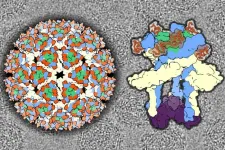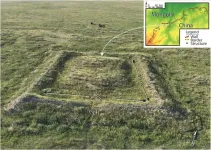(Press-News.org) New Haven, Conn. — Yale researchers have identified a drug target that may alleviate joint degeneration associated with osteoarthritis, a debilitating condition that afflicts as many as 30 million people in the United States alone, which they report on Jan. 3 in the journal Nature.
Pain relievers and lifestyle changes, such as exercise and reduced excess weight, have long been the therapies most commonly used to treat the joint stiffness and pain caused by degenerative disease, but there is a pressing need for therapies that can prevent joint breakdown that occurs in osteoarthritis.
It is known that specialized proteins known as sodium channels found in cell membranes produce electrical impulses in “excitable” cells within muscles, the nervous system, and the heart. And in previous research, Yale’s Stephen G. Waxman identified the key role of one particular sodium channel, called Nav1.7, in the transmission of pain signals.
Now, the labs of Chuan-Ju Liu, the Charles W. Ohse Professor of Orthopedics, and Waxman, the Bridget M. Flaherty Professor of Neurology and professor of neuroscience and pharmacology, both at Yale School of Medicine, have found that the same Nav1.7 channels are also present in non-excitable cells that produce collagen and help maintain the joints in the body.
Osteoarthritis, the most common form of arthritis, is a degenerative disease caused by the breakdown of cartilage that eases friction between the joints. It occurs most commonly in the hands, hips, and knees.
In the new study, the researchers deleted Nav1.7 genes from these collagen-producing cells and significantly reduced joint damage in two osteoarthritis models in mice.
They also demonstrated that drugs used to block Nav1.7 — including carbamazepine, a sodium channel blocker currently used to treat epilepsy and trigeminal neuralgia — also provided substantial protection from joint damage in the mice.
“The function of sodium channels in non-excitable cells has been a mystery,” Waxman said. “This new study provides a window on how small numbers of sodium channels can powerfully regulate the behavior of non-excitable cells.”
“The findings open new avenues for disease-modifying treatments,” added Wenyu Fu, a research scientist in the Liu laboratory and first author of the study.
END
Epilepsy drug shows promise in slowing joint degeneration in osteoarthritis
2024-01-03
ELSE PRESS RELEASES FROM THIS DATE:
Researchers create first functional semiconductor made from graphene
2024-01-03
Researchers at the Georgia Institute of Technology have created the world’s first functional semiconductor made from graphene, a single sheet of carbon atoms held together by the strongest bonds known. Semiconductors, which are materials that conduct electricity under specific conditions, are foundational components of electronic devices. The team’s breakthrough throws open the door to a new way of doing electronics.
Their discovery comes at a time when silicon, the material from which ...
Study reveals clues to how Eastern equine encephalitis virus invades brain cells
2024-01-03
An atomic-level investigation of how Eastern equine encephalitis virus binds to a key receptor and gets inside of cells also has enabled the discovery of a decoy molecule that protects against the potentially deadly brain infection, in mice.
The study, from researchers at Washington University School of Medicine in St. Louis, is published Jan. 3 in the journal Cell. By advancing understanding of the complex molecular interactions between viral proteins and their receptors on animal cells, the findings lay a foundation for treatments and vaccines ...
Unraveling the mysteries of the Mongolian Arc: exploring a monumental 405-kilometer wall system in Eastern Mongolia
2024-01-03
New study sheds light on the previously overlooked Mongolian Arc—a monumental wall system in eastern Mongolia spanning 405 kilometers. This discovery not only reveals the significance of this ancient architectural marvel but also prompts crucial questions about the motives, functionality, and broader implications of such colossal constructions. Their findings contribute to a larger multidisciplinary project exploring historical wall systems and their socio-political, economic, and environmental impacts, marking a pivotal milestone in understanding ancient civilizations and their enduring legacies.
[Jerusalem, ...
Call for EGU24 General Assembly Abstracts
2024-01-03
The General Assembly 2024 of the European Geosciences Union (EGU) will be held at the Austria Center Vienna (ACV) in Vienna, Austria and online, from 14–19 April 2024. eLTER will organise the following session:
BG8.14: Integrated solutions for landscape management of GHG balance and biodiversity in a changing environment
Convener: Syed Ashraful Alam, Katri Rankinen, Thomas Dirnböck, Harry Vereecken, Olga Vindušková
The session is co-sponsored by eLTER.
The abstract submission deadline is Wednesday, 10 January 2024, 13:00 CET.
Society is placing increasing and potentially competing demands on our environment. ...
Unlocking sustainable water treatment: the potential of piezoelectric-activated persulfate
2024-01-03
As cities grow bigger and faster, water pollution is becoming a serious problem. We need good ways to clean the water. Traditional cleaning methods, Persulfate (PS)- Advanced Oxidation Processes (AOPs), are good at treating the bad stuff in the water, but they require a lot of energy and chemicals, like special light and metals ions. This is costly and environmentally harmful. It's urgent to find better and more eco-friendly ways to clean it.
In a recent study published in Volume 18 of the journal Environmental Science and Ecotechnology, scientists ...
On-demand conformation of an artificial cytoskeleton
2024-01-03
Peptide nanotubes are tubular-shaped structures formed by the controlled stacking of cyclic peptide components. These hollow biomaterials show inner and outer faces, allowing the control over their properties.
Led by Juan R. Granja, researchers from the Center for Research in Biological Chemistry and Molecular Materials (CiQUS) presented a novel kind of cyclic peptide that, when light-irradiated, induces the formation or desegregation of nanotubes on demand. At the appropriate wavelength, the peptide switches from a folded to a flat conformation. When the planar conformation is ...
Can artificial intelligence (AI) improve musculoskeletal imaging?
2024-01-03
(Boston)—While musculoskeletal imaging volumes are increasing, there is a relative shortage of subspecialized musculoskeletal radiologists to interpret the studies. Is AI the solution?
“With the ongoing trend of increased imaging rates and decreased acquisition times, a variety of AI tools can support musculoskeletal radiologists by providing more optimized and efficient workflows,” says corresponding author Ali Guermazi, MD, PhD, chief of radiology at VA Boston Healthcare System and professor of radiology and medicine at Boston University Chobanian & Avedisian School of Medicine.
In a new article in the journal Radiology, BU researchers provide ...
Case Western Reserve researchers land $1.125 million National Science Foundation grant to advance safer, faster and less expensive medical-imaging technology
2024-01-03
CLEVELAND—Diagnosing cancer today involves using chemical “contrast agents” to improve the accuracy of medical imaging processes such as X-rays as well as computed tomography (CT) and magnetic resonance imaging (MRI) scans.
But those agents can be expensive, take more time to use and pose potential health concerns.
With a new four-year, $1.125 million grant from the National Science Foundation (NSF), researchers at Case Western Reserve University hope to develop an artificial intelligence (AI) alternative ...
PTSD: the brain basis of susceptibility - a free webinar from the Brain & Behavior Research Foundation
2024-01-03
The Brain & Behavior Research Foundation (BBRF) is hosting a free webinar, “PTSD: The Brain Basis of Susceptibility” on Tuesday, January 9, 2024, at 2:00 pm ET. The presenter will be Nathaniel G. Harnett, Ph.D., Director of the NATE Lab at McLean Hospital and Assistant Professor in Psychiatry at Harvard Medical School. Dr. Harnett is also the recipient of a 2021 Young Investigator Grant. The webinar will be hosted by Jeffrey Borenstein, M.D., President & CEO of the Brain & Behavior Research Foundation, and host of the public television series Healthy Minds.
Register today ...
Knowing how clinicians make real-world decisions about drug-drug interactions can improve patient safety
2024-01-03
INDIANAPOLIS — Drug-drug interactions causing adverse effects are common and can cause significant patient harm and even death. A new study is one of the first to examine how clinicians become aware of and process information about potential interactions and subsequently make their real-world decisions about prescribing. Based on these findings, the research team makes specific recommendations to aid clinician decision-making to improve patient safety.
“Drug-drug interactions are very common, more common than a lot of people outside the healthcare system expect. In the U.S., these interactions lead to hundreds of thousands of hospitalizations ...





